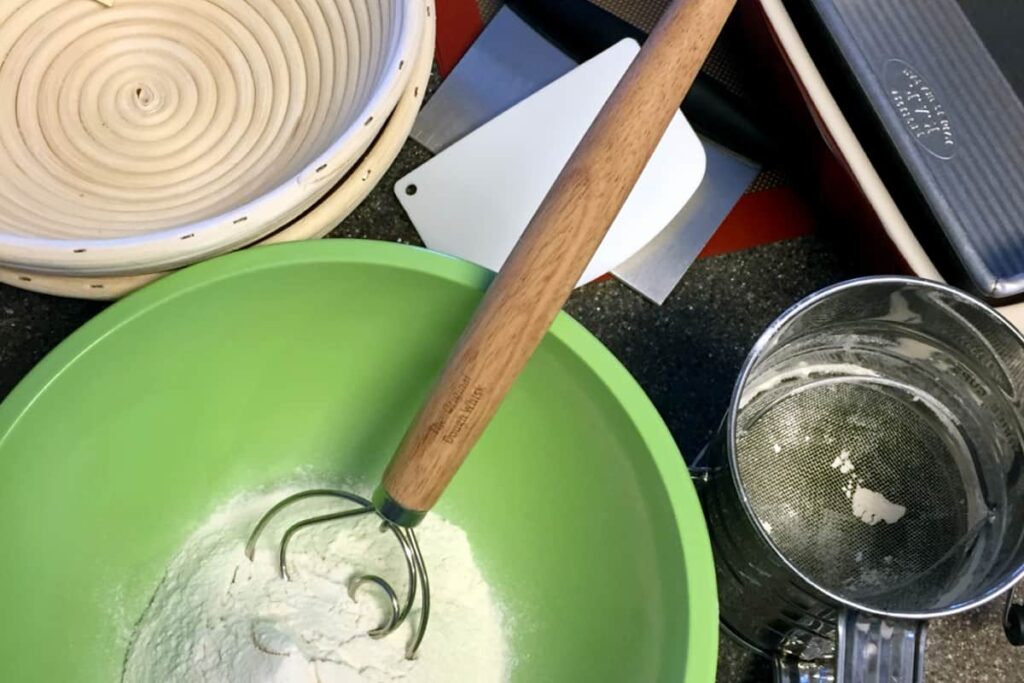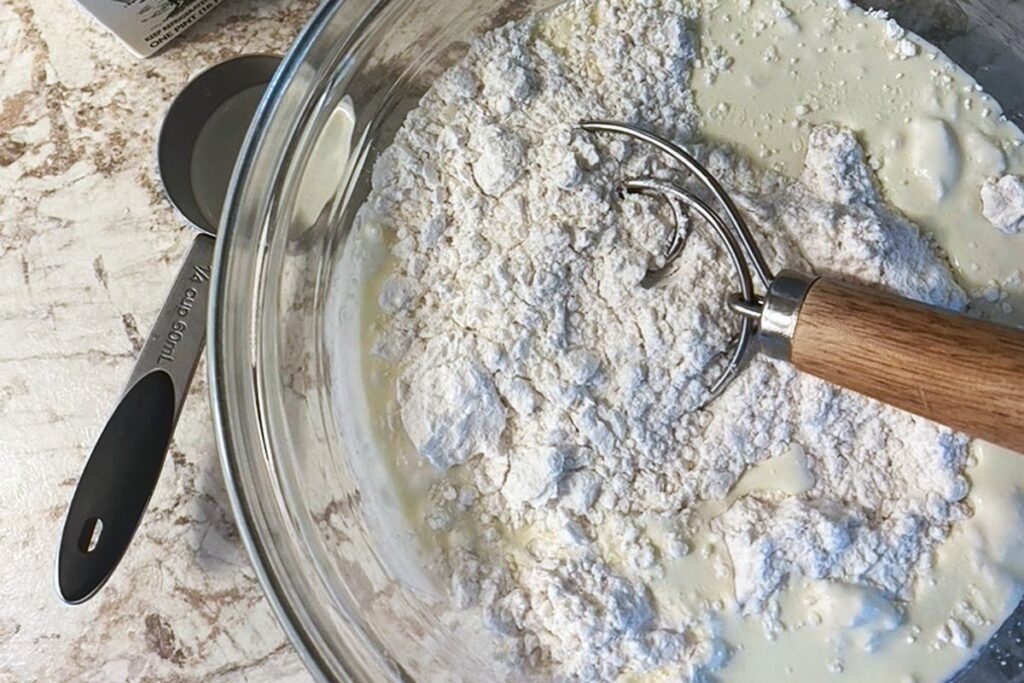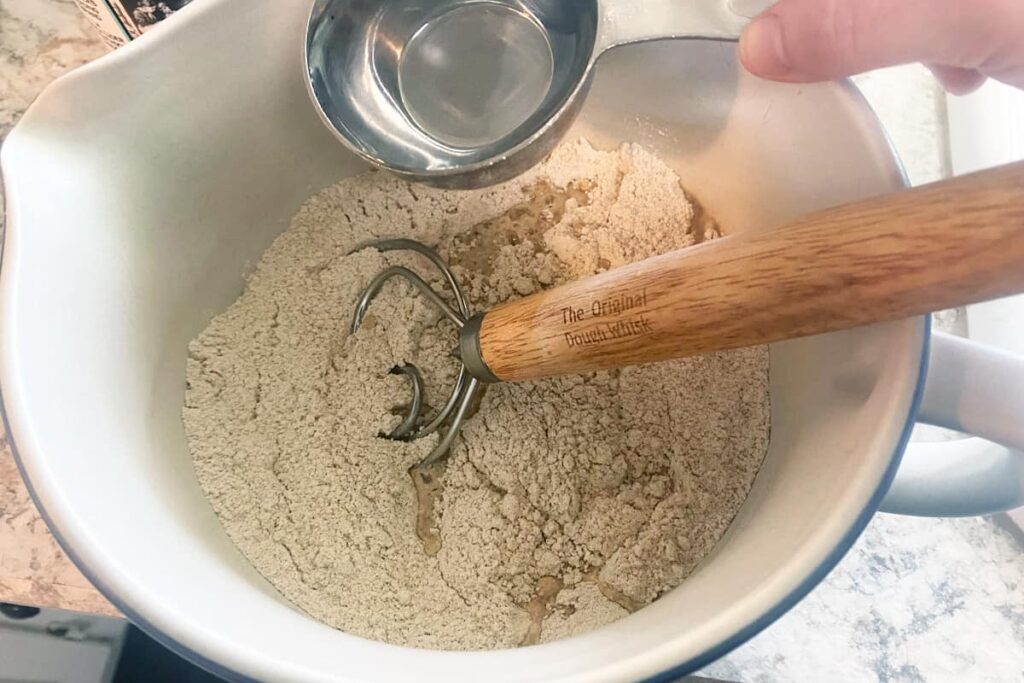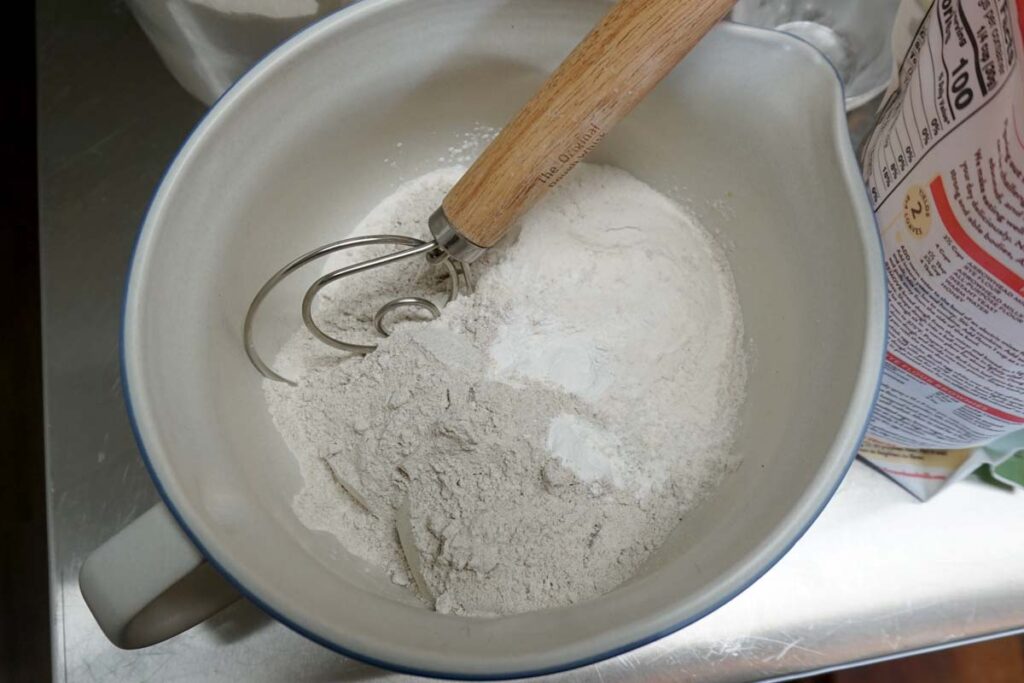As avid bakers, we know that the right tool can make all the difference in creating the perfect loaf of bread. I was gifted a Dutch-style whisk years ago by my husband, when I first got into baking, but didn’t use it that much because I was primarily making breads with all-purpose white flour.

Modern all-purpose flour is a great starting point for a baker because it’s easy to work with. Its high gluten amount (about 12%) makes it … well, all-purpose. It’s forgiving, flexible, and when you mix it correctly, it’s not sticky.
But, what if your dough is sticky? That’s where the Dutch-style dough whisk comes in.
Constructed with professional-grade stainless steel and a sturdy wooden handle, the Dutch-style dough whisk is perfect for sticky ancient grains such as Einkorn, Spelt, and Kamut. Unlike their modern counterpart, these grains have a much lower gluten content, making them sticker and more sensitive to over-mixing.
I usually use my Kitchenaid Stand Mixer for breads made with all-purpose flour, but that can be too much for ancient grains. It’s the tool you need if you want to hand mix your whole wheat dough without all the mess of it clumping on your hands.
Overview of the Dutch-style bread dough whisk

I normally use my KitchenAid stand mixer to do most of my heavy-lifting, but sometimes I don’t want to lug it out, clean it, or it just seems like overkill for the task. That when this whisk can really shine.
Simple design
The whisk comes with a fairly solid wooden handle with one circular and one coiled spiral. Unlike a standard whisk, it lays flat and the spirals have fairly large openings. This makes it ideal for thicker mixtures, which is exactly what we want when stirring dough.

Easy to clean
One major benefit of this whisk is that it’s incredibly easy to clean – dough doesn’t get trapped or clump in the wires. To clean up, just give it a quick rinse, and you’re good to go.
It’s not dishwasher safe, but it literally takes me 15-seconds to clean.
Versatility in recipes but ideal for ancient grains
Small baking tasks, like putting together a quick bread recipe, are great for this whisk–as I mentioned, sometimes it just doesn’t make sense to lug out your countertop mixer. But where the Danish-style dough whisk really shines is with baking with whole graians.
As I mentioned above, many 100% whole grains have Whole grains that have low gluten content and can be overmixed include:
- Einkorn: It is an ancient wheat variety with a lower gluten content compared to modern wheat. Einkorn dough can become tough and lose its delicate texture if overmixed
- Spelt: While spelt contains more gluten than Einkorn, it’s still less than in common wheat. Overmixing spelt can lead to a dense and heavy product, losing its tender crumb
- Kamut (Khorasan Wheat): Kamut has a unique protein structure that’s different from common wheat. Overmixing can affect its texture, making baked goods dense and heavy
- Rye: It has less gluten than wheat and can become gummy if overworked. Rye is often used in combination with wheat flour to enhance texture
- Oats: While oats don’t contain gluten, they can become dense and heavy if overmixed in recipes
- Barley: It has a lower gluten content than wheat, which can result in a heavier, denser texture if overmixed
- Buckwheat: Despite its name, buckwheat doesn’t contain gluten and can become dense if overworked
For all of these grains, mixing the dough until it comes together but not too much is much harder with a machine. Using the Danish-style dough hook is perfect as it forces you to take your time, really learning the feel of the dough and getting better at whole grain baking the more you do it.
Keeps your hands clean
When you’re making 100% whole ancient wheat baked goods, it takes time for the water to soak into the grains. Typically you’ll mix the ingredients together and let the dough sit for 15 minutes to 1-hour to let it get absorbed.
Therefore, when you first add the liquid to the flour, the dough will seem way too wet. Ancient grains are already sticky, so it’s even MORE sticky when you first mix the ingredients together. This is really where the whisk shines–in these early stages before the bread is able to come together.
Without the dough whisk, your hands are literally covered with a thick coating of dough and you have to peel it off (which is kind of gross to put that back in your dough bowl) and wash and wash the dough off.
Pros and cons
Pros
- Flexibility for handling various dough recipes, especially when working with stickier whole grain doughs like Einkorn and Spelt
- Professional-grade stainless steel and sturdy wooden handle ensure durability and long-lasting use (mine is 9+ years old and still works flawlessly!)
- Easy to clean, as dough doesn’t get caught in the wires or clump in the center
- Makes whole grain baking simple–you don’t need a fancy mixer
- Affordable at less than $10
Cons
- Not dishwasher safe
- The wooden handle can get ruined and feel rough if you don’t take care of the wood (don’t ever soak it–make sure you dry it as soon as you wash it)
- It costs money, even if it’s not a lot, which can cause a barrier to entry for some home bakers. If you don’t have a dough whisk or can’t get one, you can use a fork or a wooden spoon
Frequently Asked Questions
What are the benefits of using a Dutch-style whisk?
A Dutch-style whisk is an excellent tool for kneading dough without leaving clumps or getting your hands messy. The professional-grade stainless steel and sturdy wooden handle make it easy to work with even large bread loaves. The design helps prevent dough from getting caught in the whisk, making it quick and easy to clean up.
How to properly use a dough whisk?
To use a dough whisk, hold the handle with a firm grip and blend your ingredients with a gentle circular motion. The dough will come together more quickly and with less effort when compared to using a wooden spoon or fork.
Which size of dough whisk should I choose?
The one I have successfully used for over nine years is 13.5 inches, offering a comfortable size for use in various types of recipes. This one-size-fits-all whisk is perfect for everything from bread dough to delicate pastries, ensuring ease of use and great results.
What is the main difference between a Dutch whisk and a regular whisk?
A Dutch whisk, also known as a dough whisk, has a unique design with loops that allow for more strategic and efficient mixing of dough. It’s ideal for thick mixtures and dough, while a regular whisk is better for blending light and airy ingredients.
Where can I buy a quality dough whisk?
You can purchase a high-quality dough whisk on Amazon (here is the exact one I have) or at your local kitchenware store. This whisk has received fantastic customer ratings, making it a popular choice for those seeking a durable and efficient dough whisk.








